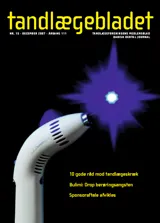Tandlægeskræk og internettet
På internettet er tandlægeskræk højt placeret blandt angsttilstande og tandlægelige emneord. Hertil kommer, at internettet er blevet en aggressiv udbyder af alle hånde budskaber om sundhed og sygdom. Information om tandlægeskræk på tandlægers hjemmeside er derfor blevet en stor faglig udfordring – og har det så noget med etik at gøre? Ja, i høj grad! For hvordan tilpasses de kommercielle interesser til de faglige og saglige informationer? Og hvilke kvalitetskrav bør opfyldes, når en hjemmeside annoncerer med behandling af patienter med tandlægeskræk? Det er de spørgsmål, der melder sig når kun 10 % af tandlægernes hjemmesider har et acceptabelt informationsniveau om tandlægeskræk. Hertil kommer så den faglige udfordring:Hvordan vejlede de patienter, der blot er lidt bange for at gå til tandlæge, og samtidig også hjælpe patienter med reel odontofobi?
Dental anxiety and the Internet: The Internet has become a dominating and aggressive mass media, where all kinds of messages about sickness and health are disseminated. Systematic searching over the course of a year reveals that dental anxiety, in terms of the number of hits, is the most common phobia. Dental anxiety also scores highly when using search terms relating to dentistry in general. A qualitative analysis of websites mentioning dental anxiety showed that 44 % related to the dentist’s clinic, and of these, only 10 % had an accepta ble level of information about dental anxiety. This presents an opportunity for a discussion on the quality requirements for odontological websites and the ethical aspects of the commercial messages of the websites, as against their scientific and technical content. There is a considerable divergence between the amount of attention given to dental anxiety on the internet and the level of research-related activity in the form of articles in PubMed, where only 0.5 % of all articles on odontological subjects deal with dental anxiety.


